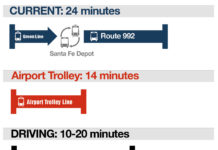OP-ED Contributor
By Lisa Eyler and Natalia Zorrilla
You round the corner on your morning canyon walk and are surprised by a disheveled man sleepily emerging from the sagebrush. Later, as you wait impatiently in afternoon traffic, an elderly woman pushes a cart piled high with all her worldly possessions across Balboa Avenue. You wonder, yet again, what can be done to address the pressing problem of homelessness in our neighborhood and our city.
Solutions to end homelessness, and the role that Clairemont should play, are on all of our minds. As we ponder these difficult issues, we urge residents of Clairemont to consider how we can enhance the health, well-being and prosperity of our community by making sure that all of our neighbors have a home. In order to work together creatively and effectively, we should rely on proven solutions. Luckily, a great deal is known about the causes of homelessness and the benefits that come from improving living conditions for all members of a community.
Who are the people experiencing homelessness?
Most people become homeless when they lose a job or suffer serious illnesses and can no longer afford the high cost of housing in San Diego. Victims of domestic violence are also at high risk for homelessness. Of the approximately 8,500 people in San Diego County who are without homes, 1,545 are in families, 813 are children or young adults, and 1,312 are veterans. The majority of people experiencing homelessness do not have substance use disorders or suffer from mental illness.
What strategies work to reduce the number of people living without shelter?
Supportive housing provides both housing and voluntary services, such as treatments for mental and physical illness and job training. This approach has a 77% – 97% success rate across the US and Canada — the vast majority of residents remain in homes after a year, and very few leave after that time period. Providing a home immediately, along with voluntary drug treatment for those who need it, is not only more effective in keeping people housed, it is equally effective in keeping people sober compared to approaches that impose restrictions, like work or sobriety. In short, the evidence-based solution to homelessness is to provide homes.
As a Clairemont resident, how does homelessness affect me?
In our own community of Clairemont, an estimated 50-100 people are living without permanent shelter. Most who are homeless remain close to where they used to live and work. The costs of homelessness affect all of us — almost $35,000 of our tax money is spent for each year that a person with a long history of homelessness and chronic health issues remains on the streets (in 2018, there were 2,171 people in this situation in San Diego County). Losses in tourism revenue and decreased property values from unhoused citizens add insult to injury. In addition, many current Clairemont residents may be one small step away from losing their homes. The majority of U.S. families (about 60%) say that they do not have the savings to cover an emergency cost of $1000, and most who rent housing are spending half to 70% of their income on rent and utilities. We can provide a safety net by closing the gap between income and the cost of keeping a roof over our neighbors’ heads.
How does ending homelessness and keeping our neighbors in their own homes lead to a more prosperous Clairemont?
Communities that address homelessness with supportive and affordable housing solutions generally see economic benefit. Building affordable homes on underutilized property or replacing outdated buildings creates jobs, improves aesthetics, and yields additional revenue for the community through property taxes. Importantly, providing affordable housing (rent less than 30% of income) allows Clairemont residents to spend their money on staying healthy and adequately fed. In addition, it means more money to spend at our local businesses. Furthermore, businesses benefit when workers can live nearby and have stable housing, which reduces employee turnover.
Together, we can improve the health and economic stability of Clairemont by providing safe and supportive places to live and ensuring that all who live and work here can afford a home. Guided by evidence, ingenuity, and compassion, we can bring all of Clairemont under one roof and end homelessness in our fine city.
Lisa and Natalia are Clairemont residents and members of the Clairemont Coalition on Homelessness (CCH). For more information on CCH and to see sources for the information mentioned in this piece, please see the hyperlinked version at the CCH website: homelessclairemont.org



